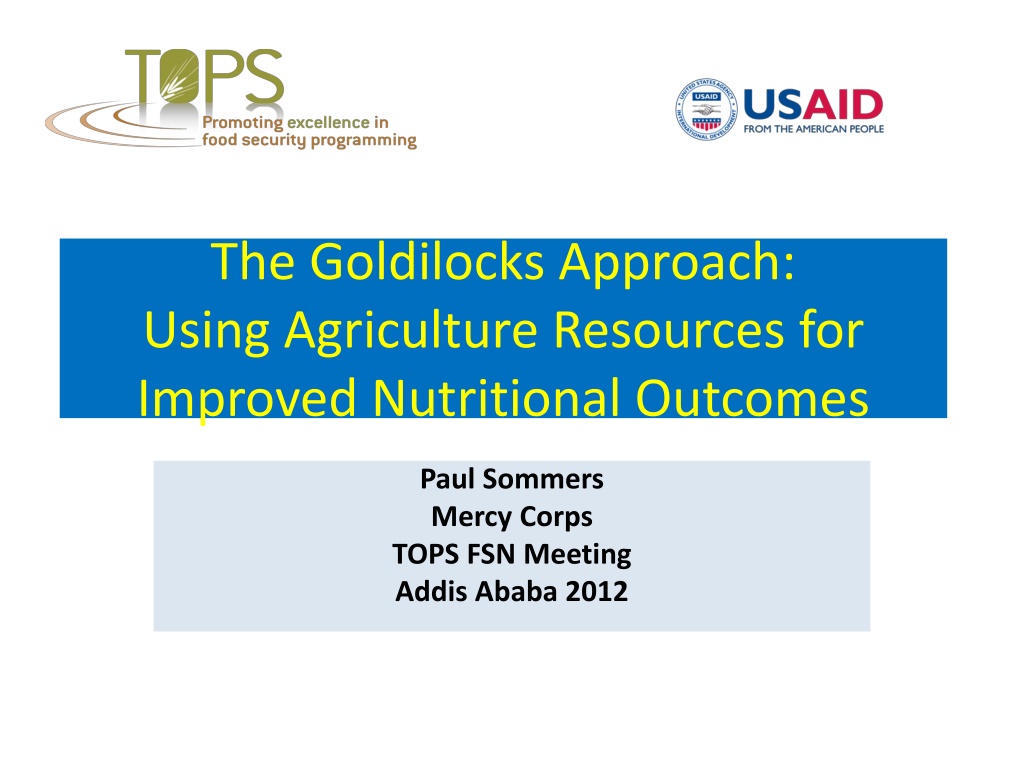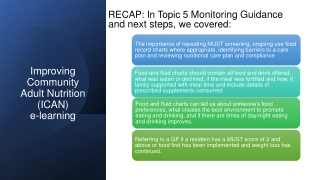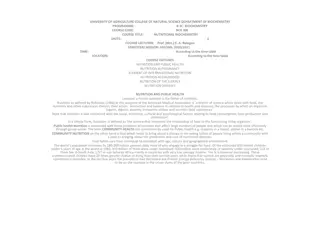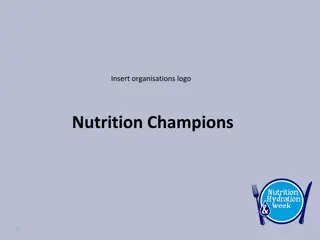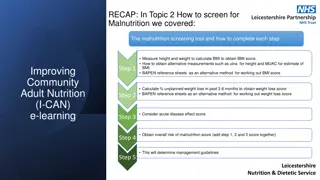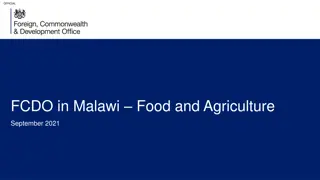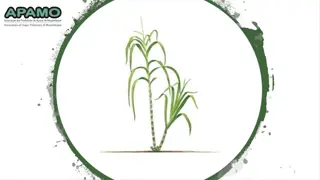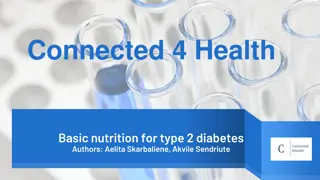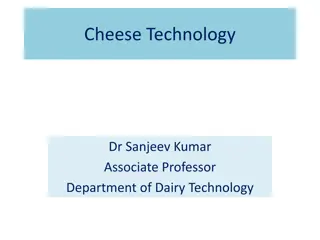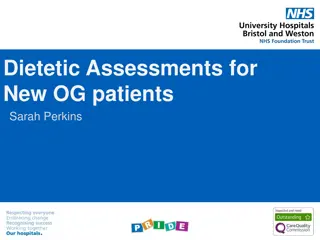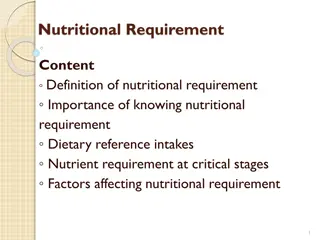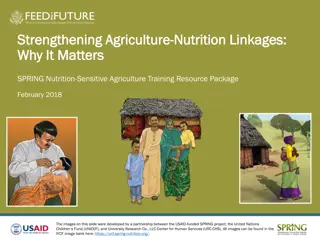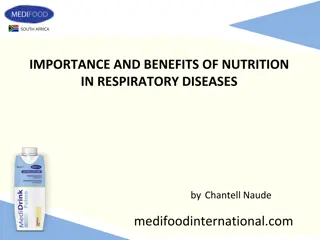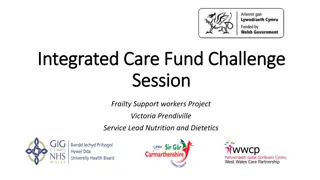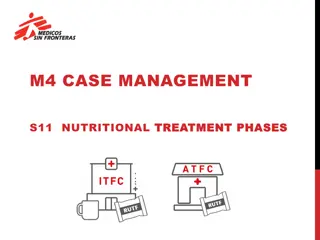Enhancing Nutritional Outcomes Through Agriculture Resources
Explore the innovative approach of using agriculture resources to improve nutritional outcomes, focusing on creating demand for locally grown foods and increasing economic crop value. Key messages highlight the importance of addressing both supply and demand aspects for successful small farmer income growth and children's development. Engage in group activities to identify strategic interventions in the value chain and initiate joint programming processes for enhanced agricultural and nutrition projects.
Download Presentation

Please find below an Image/Link to download the presentation.
The content on the website is provided AS IS for your information and personal use only. It may not be sold, licensed, or shared on other websites without obtaining consent from the author. Download presentation by click this link. If you encounter any issues during the download, it is possible that the publisher has removed the file from their server.
E N D
Presentation Transcript
The Goldilocks Approach: Using Agriculture Resources for Improved Nutritional Outcomes Paul Sommers Mercy Corps TOPS FSN Meeting Addis Ababa 2012
Session Outline 1. Overview of Topic 10 minute 2. Group work Part 1 45 minutes 30 minutes small group discussion 15 minutes session group discussion Break Part 2 45 minutes 30 minutes small group discussion 15 minutes session group discussion 3. Way Forward 15 minutes sommers.csucid@gmail.com
Key Messages for Group Work View nutrition not as a problem but as part of your agricultural growth solution Creating demand for nutrient dense locally grown foods can lead to increased economic crop value Solving nutrition problems is not only a supply side issue-it is also a demand side issue. Success is measured when both small farmer income andtheir children s growth happens sommers.csucid@gmail.com
Imagine No Silos sommers.csucid@gmail.com
Making Friends sommers.csucid@gmail.com
Group Work Part 1 Each table will be provided with one crop to use as your case study How would you propose using the value chain approach to improve both nutritional outcomes as well as income for poor farming Households? Where , in the chain, do you see the most strategic interventions? Why? sommers.csucid@gmail.com
Step by Step Step #1 Write down key components in a value chain for your case study crop. Step #2 Identify interventions and tools in your nutrition and agricultural tool kits to achieve the outcome. Step #3. Identify the most strategic intervention in the chain where agriculture and nutrition project resources can make the greatest impact. sommers.csucid@gmail.com
Group Work-Part 2 With your understanding now of how you can contribute to the HFS 4 pillar framework, availability, access, utilization, resiliency, how do you propose to begin the conversation of a joint programming process with your nutrition colleague? Where is the nexus in your work program? (hint : start w/ outcome indicators) sommers.csucid@gmail.com
Ag. HFS Tool Box 1) Availability- intensify, diversity, productivity (production/post harvest) 2) Access- a) From farm resources (fresh /stored) b) off- farm- providing service within specific value chains (input supply, labor for crop production, harvest/post- harvest, storing, transport, sales) 3) Utilization- a)improved post-harvest chain b) demand creation for nutrient dense foods. 4) Vulnerability/resiliency - combination of 1-3 building on the HH s resource base 10 min. sommers.csucid@gmail.com
Nutrition HFS Tool Box Demand side: 1) Availability- promote diversity in the HH food resource base. Promote increase the quantity of food produced. 2) Access- Promote quality improvement in current food crops grown. 3) Utilization- Create demand for nutrient dense foods. Promote food safety. 4) Resiliency- ID gaps in the lean season. Increase number of months HH s are food secure. Loop back to #1 and 2. sommers.csucid@gmail.com
Framework for adding Nutrient Value for the End User How to upgrade/create/add nutritional value to HH food supply chains? Classical think: Jump from farm to fork- Use ag. resources to produce a sufficient quantity of high quality foods year round. But in-between production and consumption several vital steps need to take place: ^seed quality, CA, harvest, post harvest. Your challenge is to id. Clear, simple, tweaks of existing activities w/in the existing HH food supply chains. Labor, capital using existing land no expansion =intensify/diversify sommers.csucid@gmail.com
How does adding nutrional value also lead to increasing economic value? 4 step process 1) Start with a clear dietary gap/shortage in the community. Can also be viewed as potential market opportunity. Solution: both supply and demand driven . 1) To improve nutrition HH s can grow their own a) Availability b) Sell (access) or a combination of the two. What is stopping them from achieving availability? Improving access? 2) How can we use nutritional value to increase demand/acceptability? Ag. Is not only about supply side but also demand side. 3) Value chains provide a framework for income and nutritional value- Example orange flesh sweet potato. Supply side provide inputs to increase amount at the same time create demand promotional campaign on benefits of consuming OFSP sommers.csucid@gmail.com
Post harvest Key Messages Keep a focus on quality throughout the supply chain Keep it healthy: at harvest and from there on Keep it cool: check optimum temperature requirements Keep it gentle: no rough handling/bumpy rides Keep it clean: storage rooms, equipment, sanitation tanks, packaging materials and people Keep it breathing: vegetables are alive, airflow and ventilation are vital in storage, transport and packaging sommers.csucid@gmail.com
Feasible and Strategic Interventions for income and nutrition outcomes GROUPS Availability Access Utilization Resilience Mother Care I.D. plants needed to fill in dietary gaps Farm/off farm supply chain based income opportunities Increase # of months of food security Increase crop diversity/dietary diversity Farm Production Intensify/diversity Quality, quantity, market timing Post-harvest/food safety Low input /climate protecting methods Marketing Increase quantity and quality ID high value crops nutrient dense and income Create demand for locally grown nutrient dense food Adding value to crops/livestock creates a stable/productive land resource VSLA Loans for inputs Loans for harvest labor/processing/storage/tran sport/ Loans for Storage/processing Loans for rehabilitation efforts- soil fertility /moisture conservation erosion control etc. sommers.csucid@gmail.com
MAP OF A VALUE CHAIN sommers.csucid@gmail.com
T-2 Goal FFP s goal for multi-year development programming is to reduce risks and vulnerabilities to food insecurity and increase food availability, access and utilization /consumption. Title II programs must target the vulnerability of food insecure individuals, households and communities directly. sommers.csucid@gmail.com
Introduction 1. Name 2. Organization 3. Field experience with leveraging agriculture for improved nutritional outcomes 4. One question your table wants answered in the session. sommers.csucid@gmail.com
Farmer Input Supplier Production Buyer Farmer Market Access Post Harvest sommers.csucid@gmail.com
Supply/Value Chain What does the term mean to you? How does it impact.. Positively or/negatively (land use labor, capital) Food availability? Food access? Utilization? Shocks? How do you see VC s interventions linked programmatically to nutritional outcomes/indicators 10 min. sommers.csucid@gmail.com
